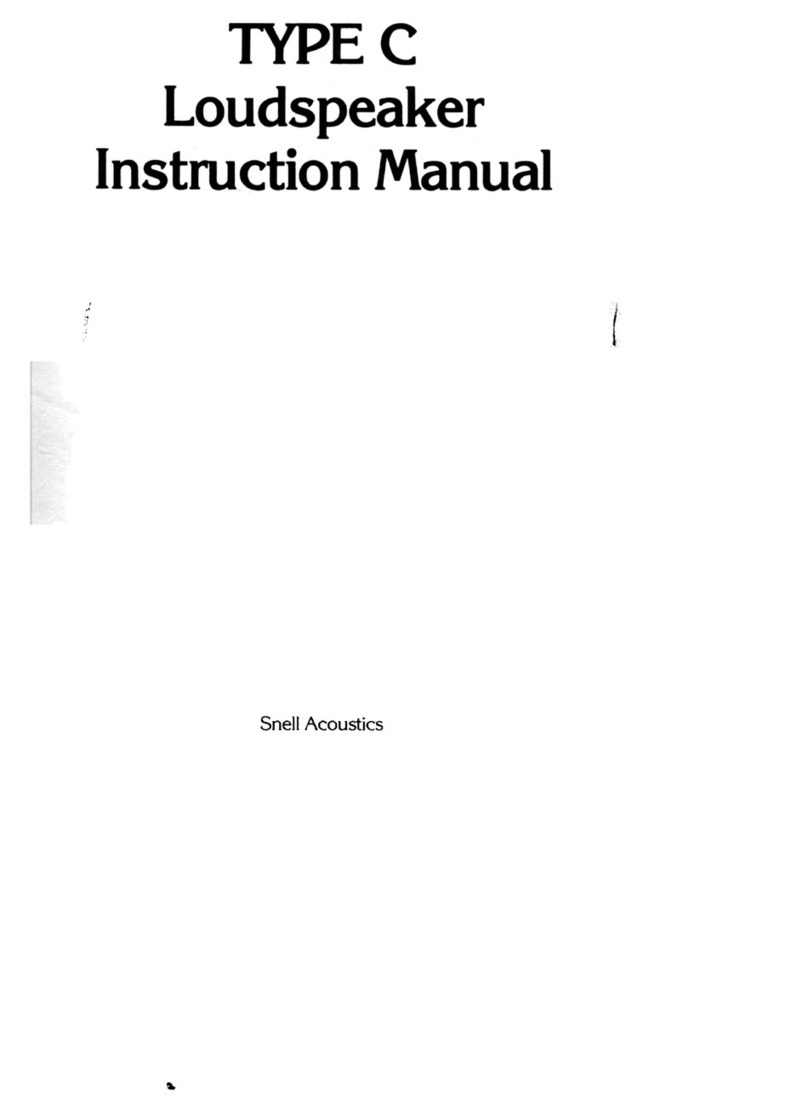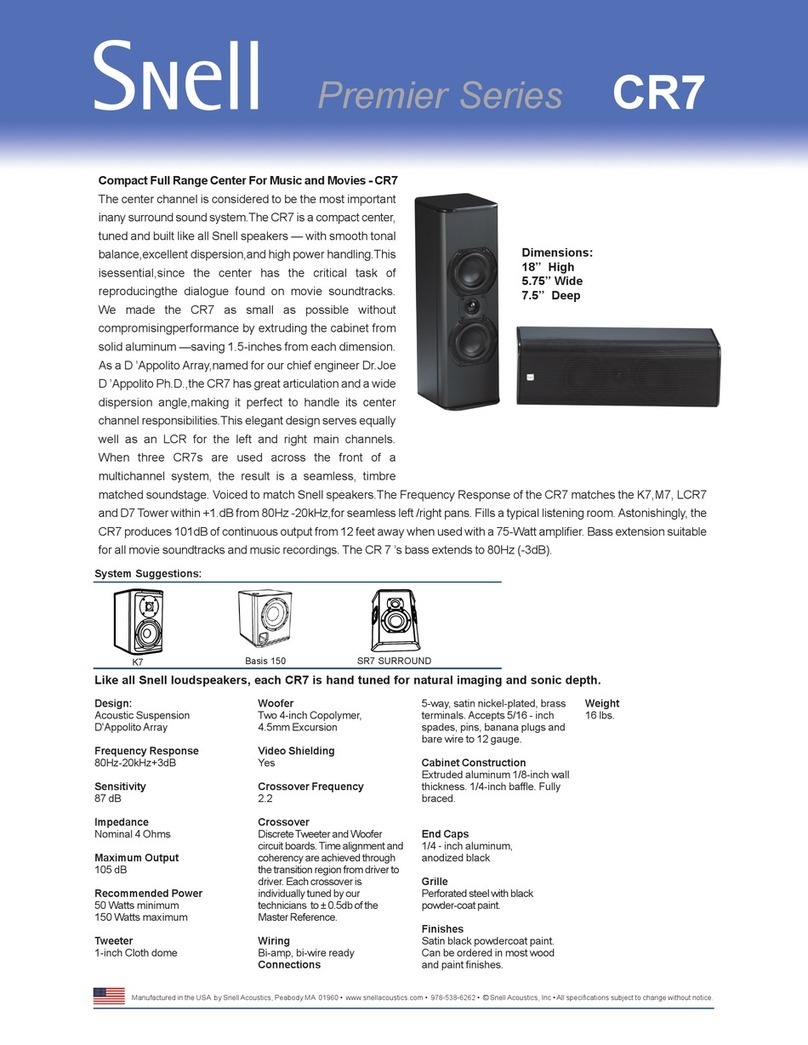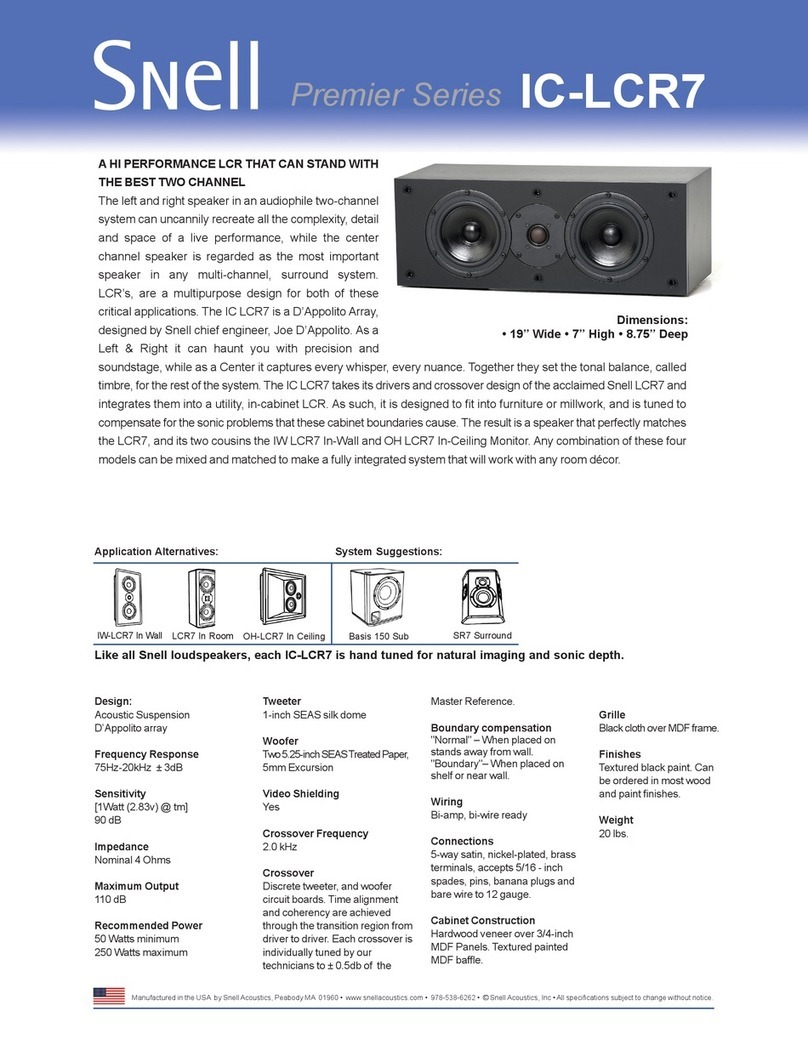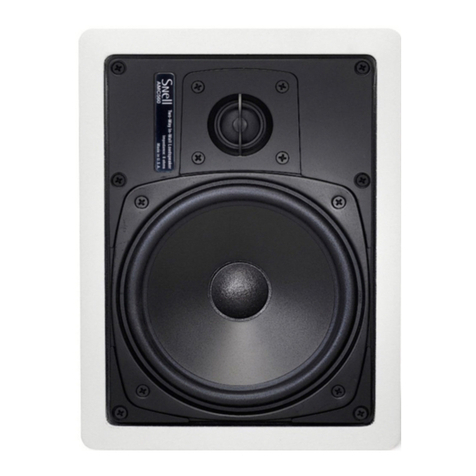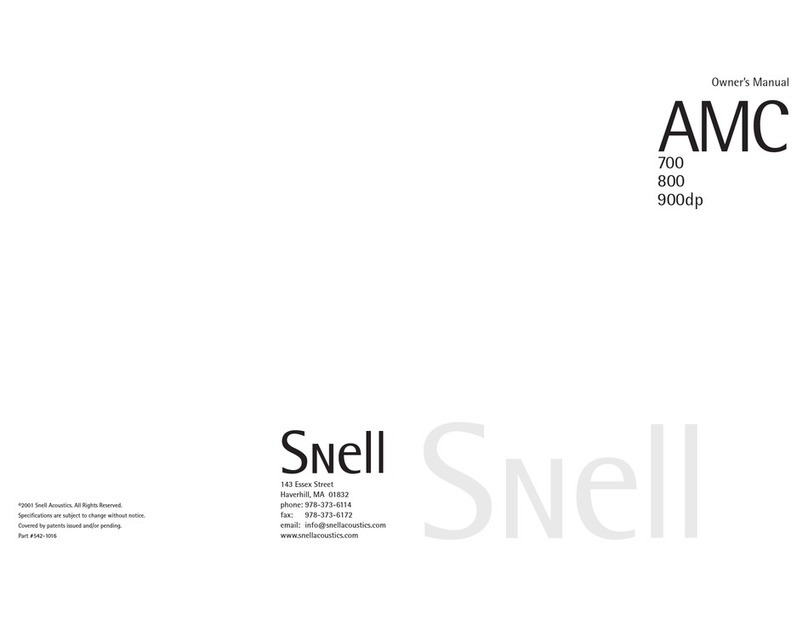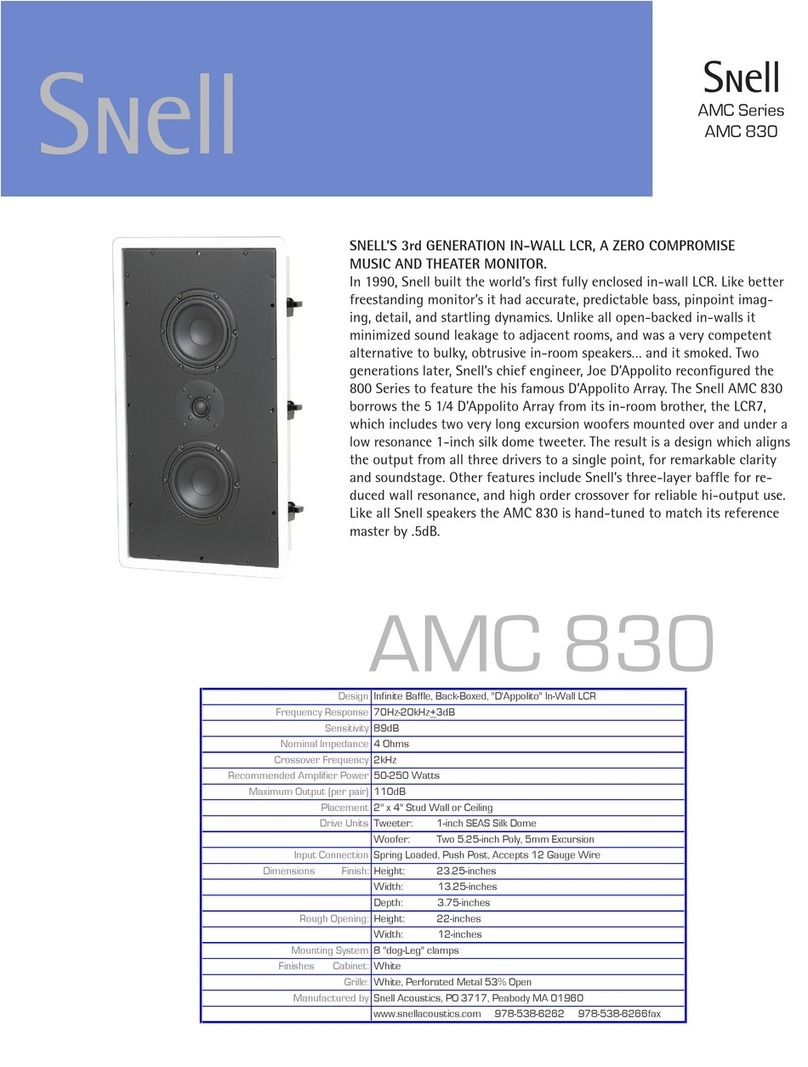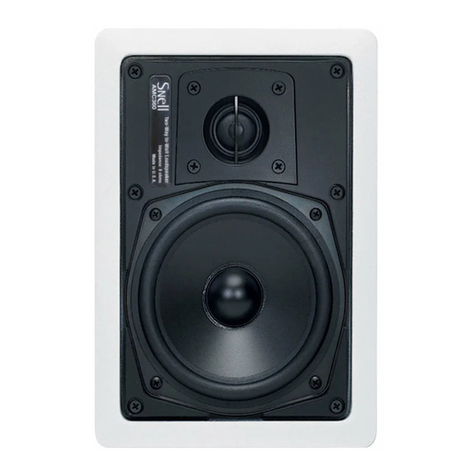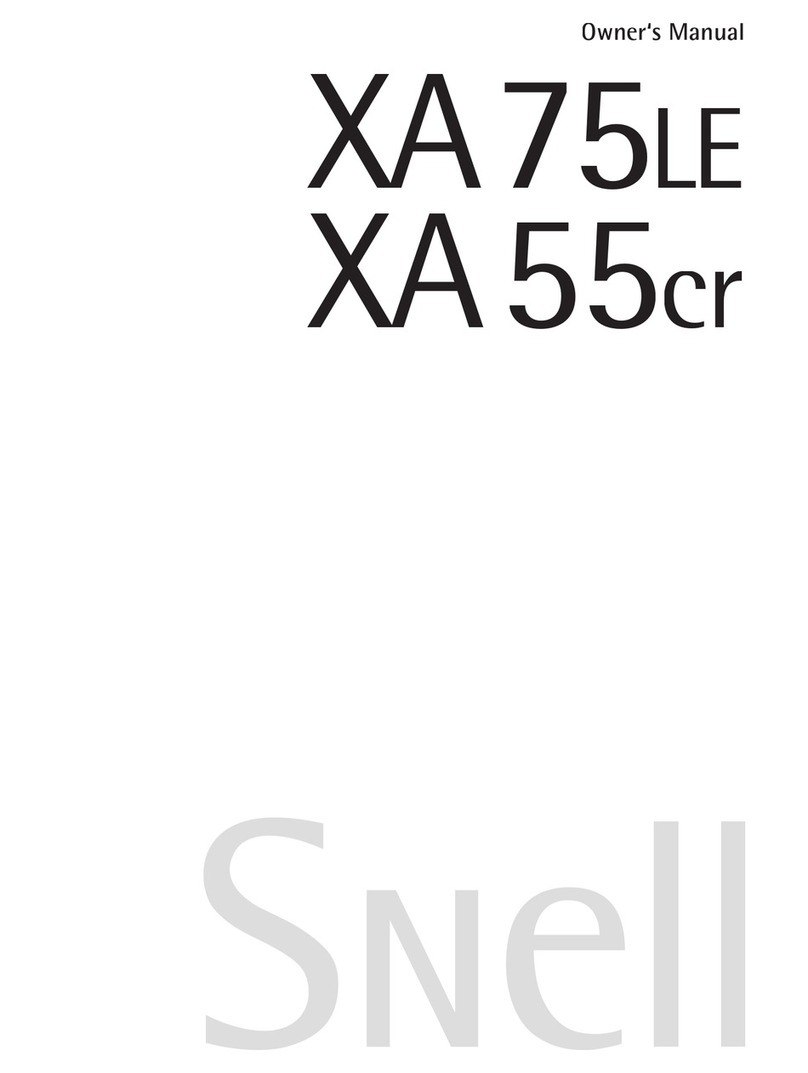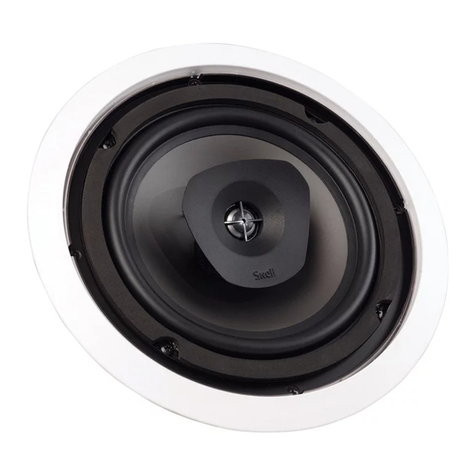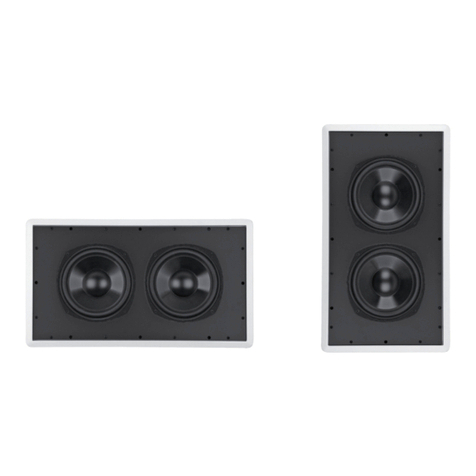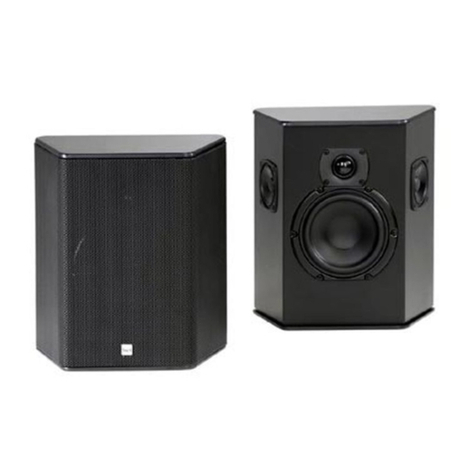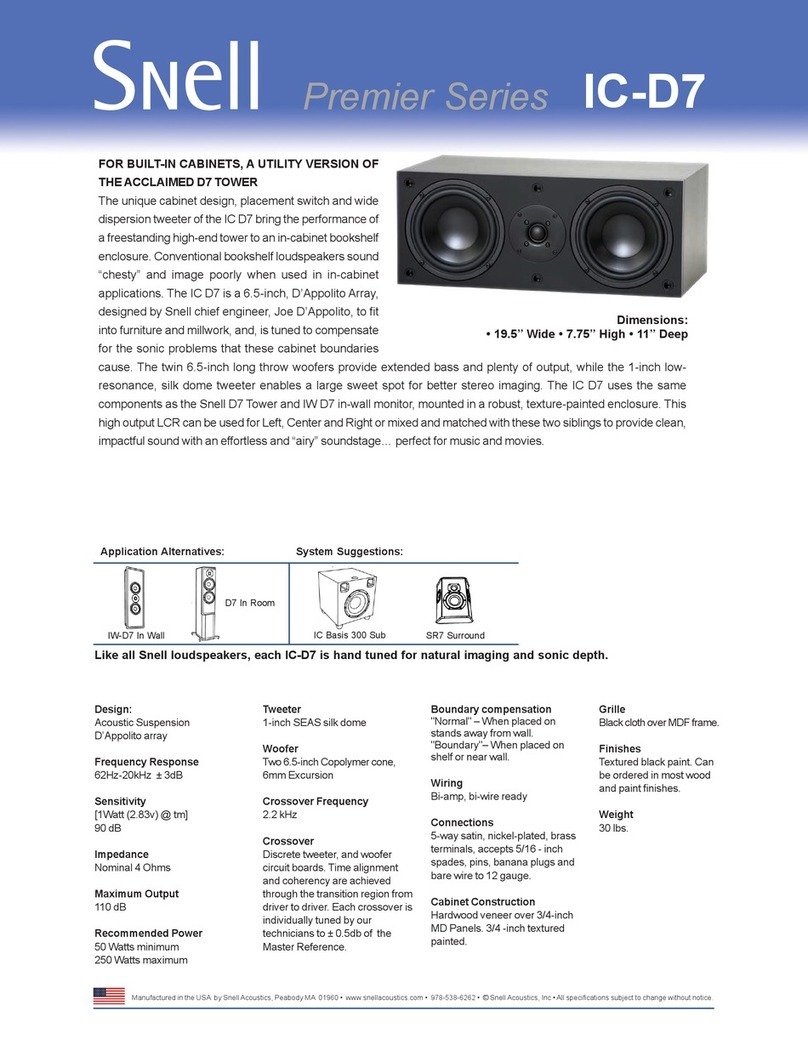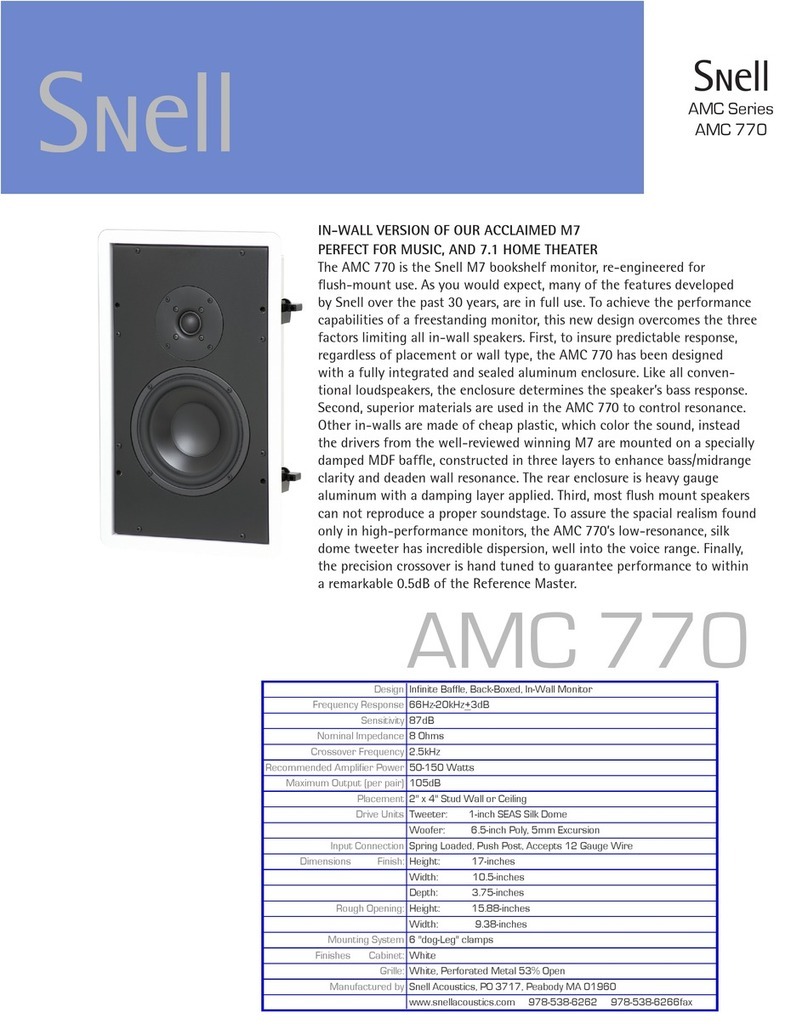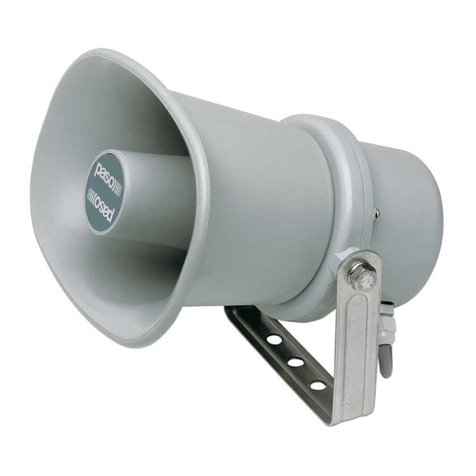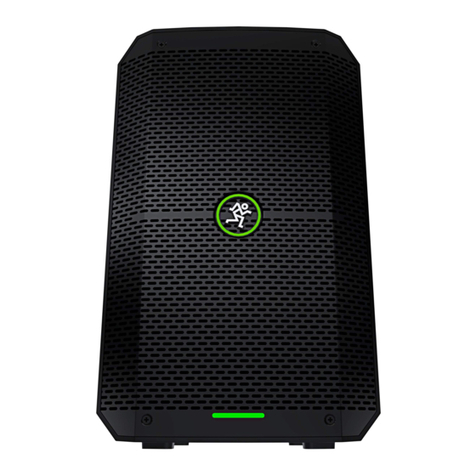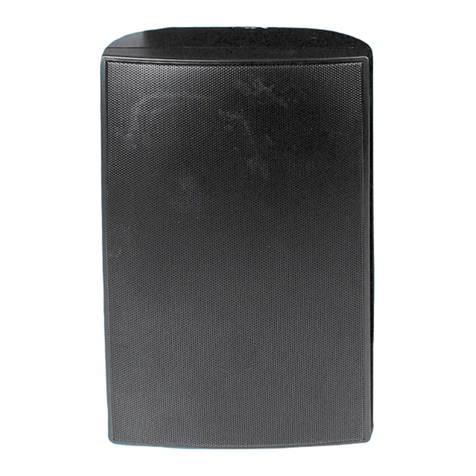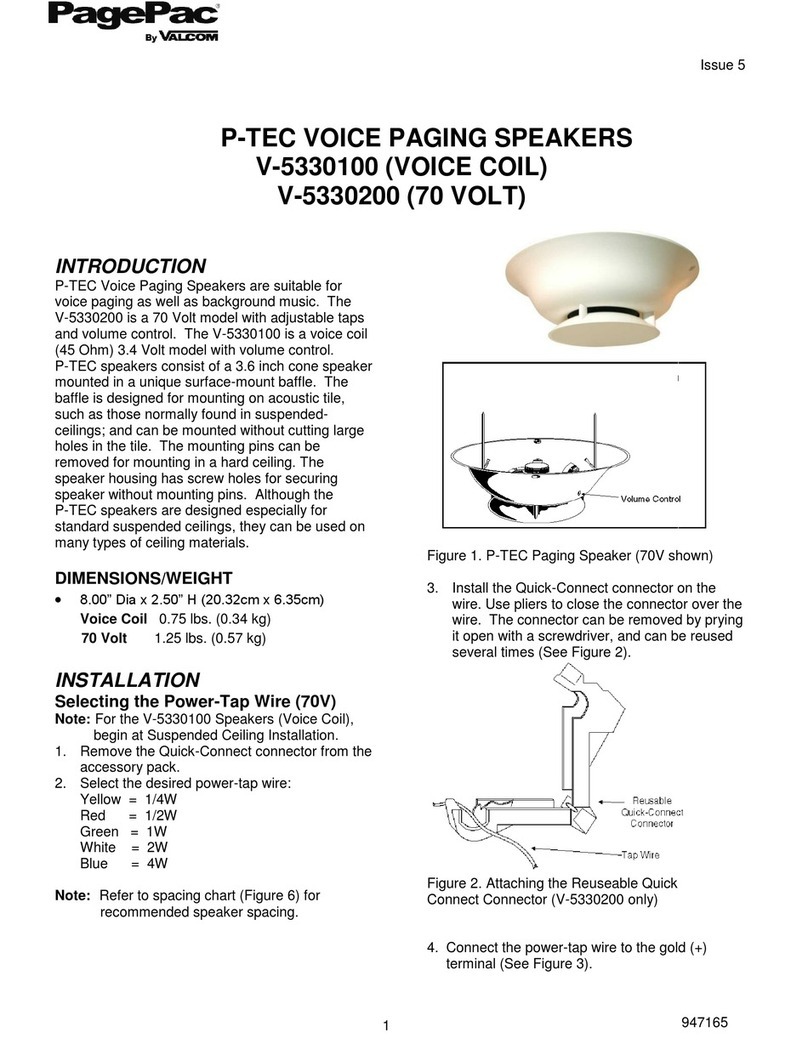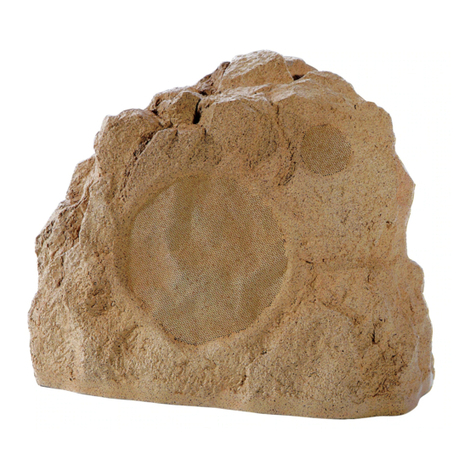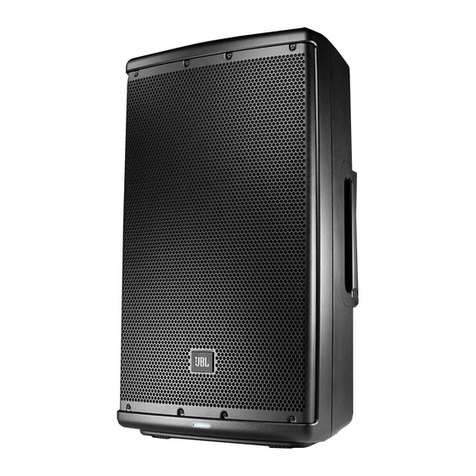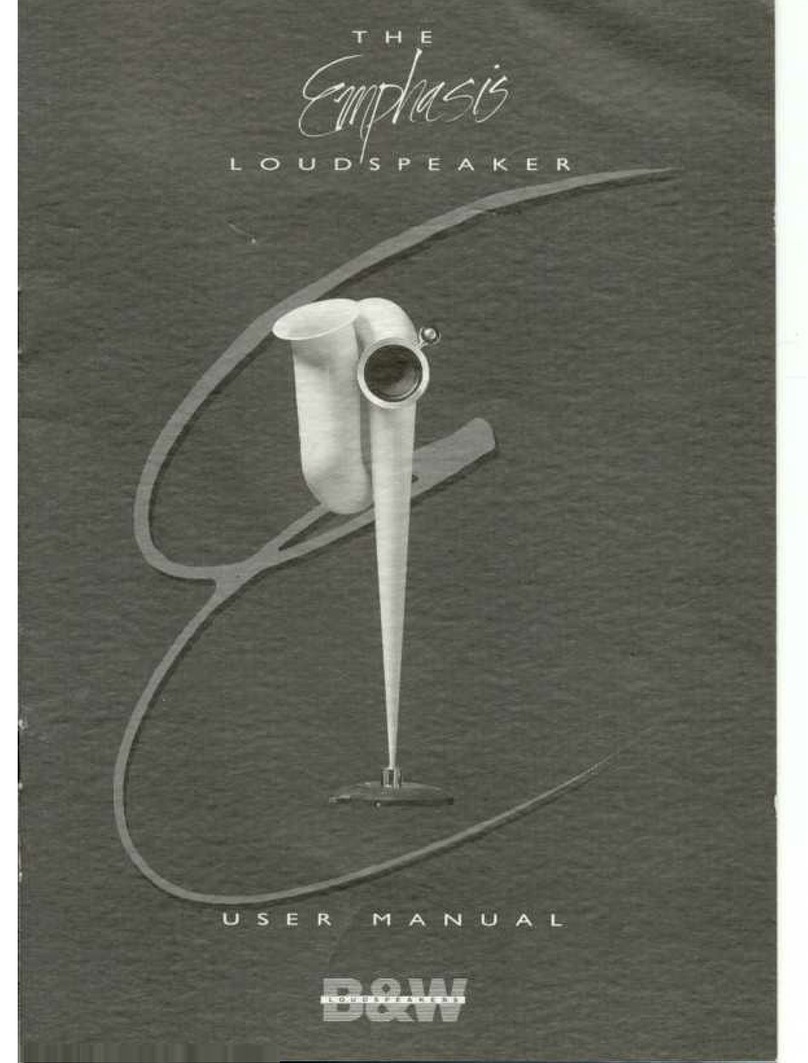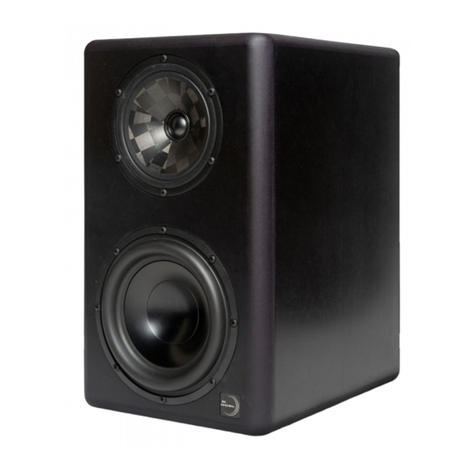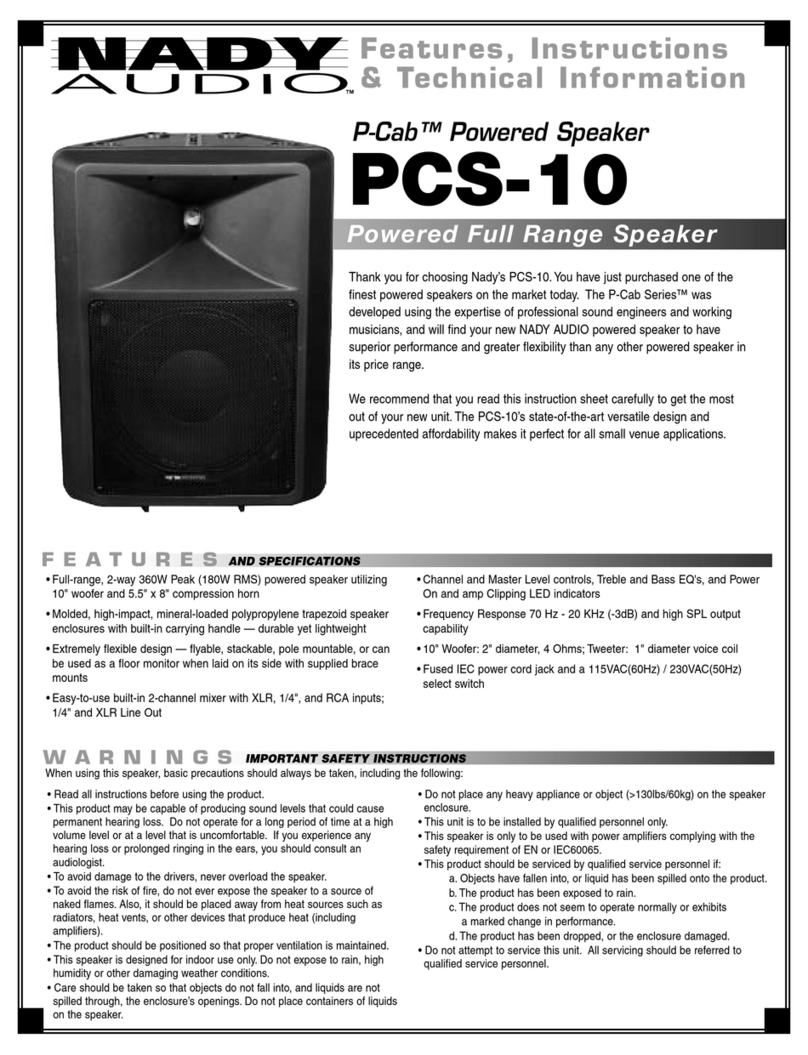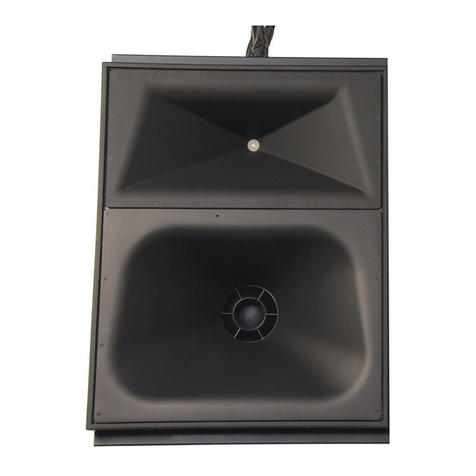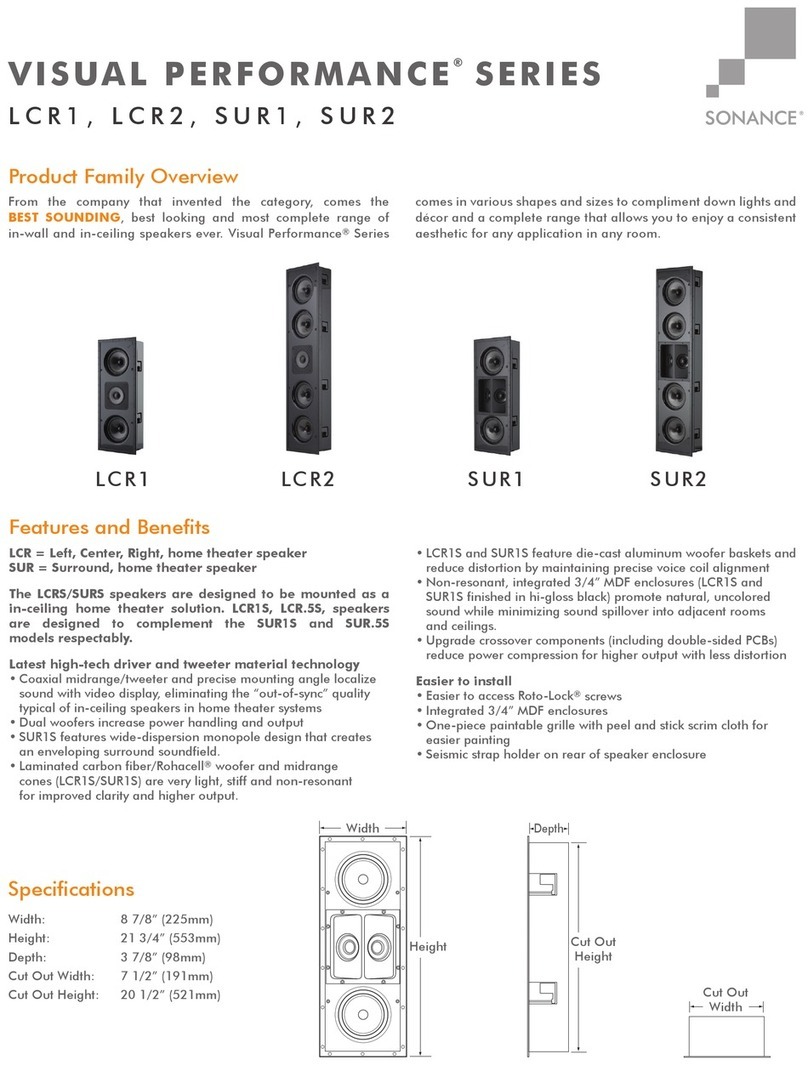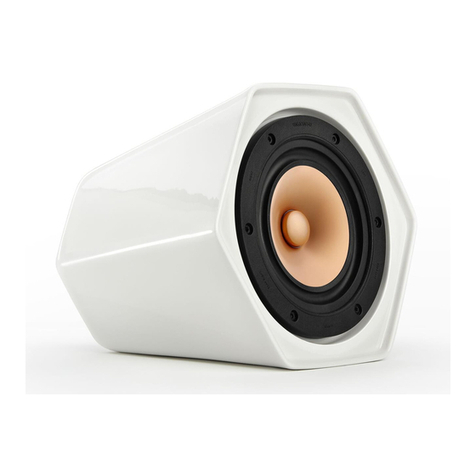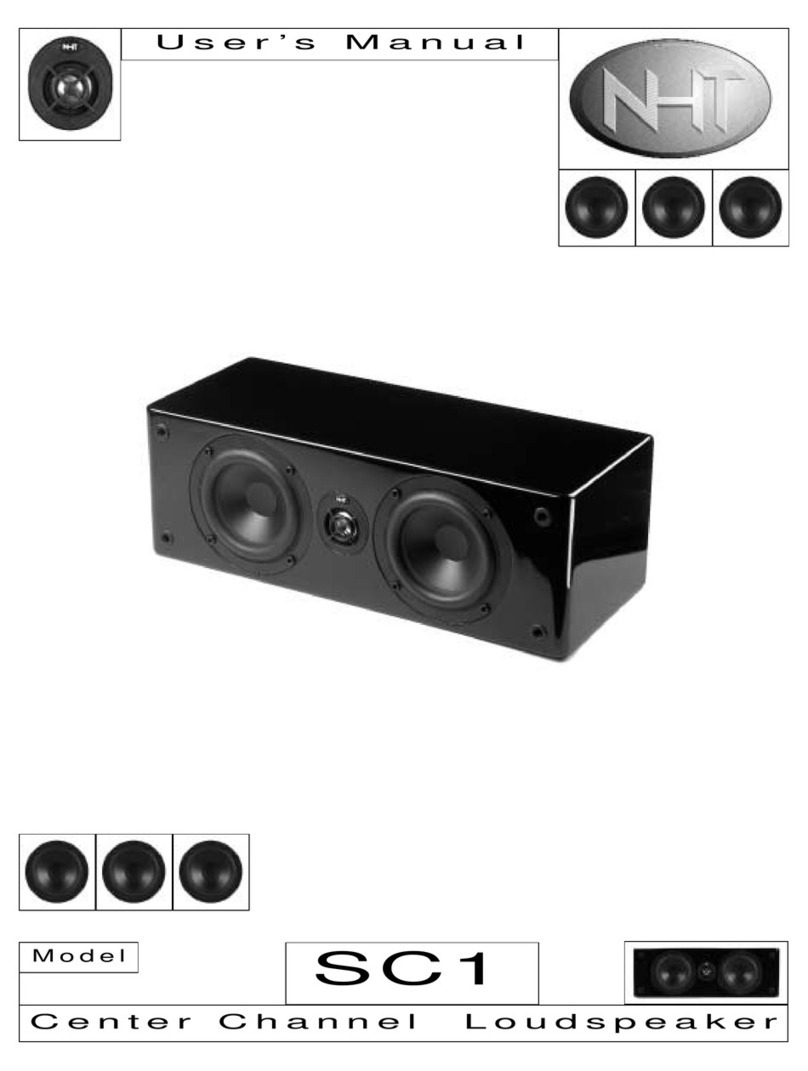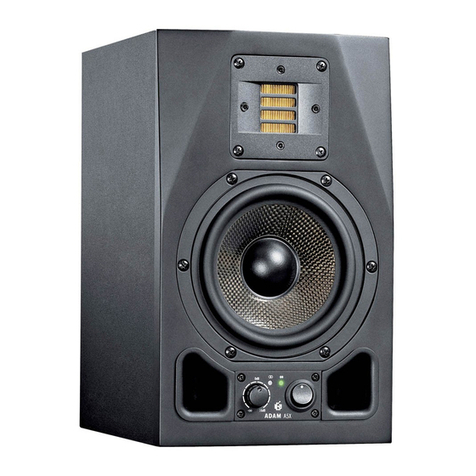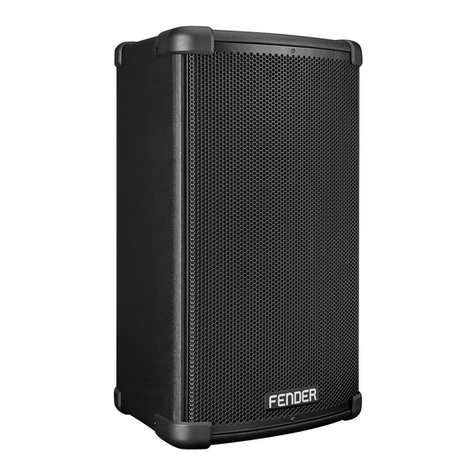Snell IC-B7S User manual

IC-B7S
IC-B7VH
IC-C7S
IC-C7VH
Owner’s Manual

2
SPECIFICATIONS
Frequency Response (±3dB)
Recommended Amplifier
Nominal Impedance
Sensitivity (2.83v at 1m)
Tweeter
Midrange
Bass Driver
Crossover Points
Boundary Compensation
Grille
Dimensions
(HxWxD)
Finish*
Weight
* Custom paint and grilles are available for an extra charge
IC-B7S
IC-B7VH
48 Hz–20 kHz
75–250W
4 ohms
89dB SPL
1” SEAS Excel Millenium
Dual 41/2-inch (114mm)
SEAS Excel Magnesium
Dual 8-inch (203mm)
Scanspeak polycone
300 Hz / 2.8kHz
Yes
Black cloth over MDF frame
30 x 13 x 11 inches
†
(762 x 331 x 280mm)
depth includes 5/8” (16mm) grille
Textured black paint
63 lbs (28.6 kg) / each
†13 x 30 x 11 inches (331 x 762 x 280mm)
with horizontal orientation
IC-B7S
48 Hz-20 kHz
75–250W
6 ohms
89dB SPL
1” SEAS Excel Millenium
Dual 41/2-inch (114mm)
SEAS Excel Magnesium
Dual 8-inch (203mm)
Scanspeak polycone
300 Hz / 2.8kHz
Yes
Black cloth over MDF frame
21 x 161/2 x 11 inches
(534 x 420 x 280mm)
depth includes 5/8” (16mm) grille
Textured black paint
60 lbs (27.3 kg) / each
IC-B7VH

3
IC-C7S
48 Hz-20 kHz
75–250W
4 ohms
89dB SPL
1” SEAS silk dome
Dual 41/2-inch (114mm)
SEAS treated paper
Dual 8-inch (203mm)
Scanspeak polycone
300 Hz / 2.8kHz
Yes
Black cloth over MDF frame
21 x 161/2 x 11 inches
(534 x 420 x 280mm)
depth includes 5/8” (16mm) grille
Textured black paint
60 lbs (27.3 kg) / each
IC-C7VH
48 Hz–20 kHz
75–250W
4 ohms
89dB SPL
1” SEAS silk dome
Dual 41/2-inch (114mm)
SEAS treated paper
Dual 8-inch (203mm)
Scanspeak polycone
300 Hz / 2.8kHz
Yes
Black cloth over MDF frame
30 x 13 x 11 inches
†
(762 x 331 x 280mm)
depth includes 5/8” (16mm) grille
Textured black paint
63 lbs (28.6 kg) / each
†13 x 30 x 11 inches (331 x 762 x 280mm)
with horizontal orientation
IC-C7S IC-C7VH

4
INTRODUCTION: HIGH END PERFORMANCE IN A PLAIN WRAPPER
The concept behind the Snell IC (In-Cabinet) series models is simple — loudspeakers that deliver
performance equivalent to the acclaimed, elegantly-finished Series 7 in-room models, that are
housed in cabinets with a “utility” finish, and are mechanically and acoustically designed for
easy integration into built-in installations.
These simply finished models are in no way acoustically or mechanically inferior to the in-room
Snell speakers. They use the same high-quality parts as their in-room counterparts — high
excursion woofers, wide dispersion tweeters, low resonance cabinets and audiophile grade
crossovers components. This ensures that the sound they produce is as powerful, yet clean and
effortless, as the in-room speakers from which they are derived.
In addition, the IC Series models incorporate design elements that anticipate the unpredictable
acoustical characteristics of custom installations. In some custom installations, for example,
the location of the bass drivers can cause their sound to interact with the physical surround-
ings and produce a mid-bass response error. This results in a “heavy” or “chesty” quality that is
particularly noticeable in voices. The Snell IC models have Boundary Compensation switches to
help control this problem.
Design elements such as this, and many others, ensure that the IC Series models provide the
discerning listener with the same engaging experience as that provided by a traditional loud-
speaker.

5
PLACEMENT OF THE FRONT CHANNEL SPEAKERS
A home theatre system includes three loudspeak-
ers placed across the front of the listening room.
The distance between the left and right speakers
determines the width of the stereo image. If
the speakers are placed too close together, the
image will be too narrow; too far apart and the
blend will suffer, creating a hole in the middle.
When properly placed, your speakers will create
a continuous “virtual image” from left to right,
with an illusion of sound outside, in front of, and
behind the speaker systems.
We recommend an angular separation between
45 degrees and 60 degrees (when viewed from
above). At the minimum 45° separation the
distance between the speakers is 75% of the
distance from the speakers to the listener. At the
maximum 60° separation the distance between
the speakers is equal to the distance from the
speakers to the listener.
Creating a seamless sound image across the front of the speakers requires careful placement.
The distance from the left, right, and center channel speakers to the listener location should be
as close to equal as possible.
The front channel speakers should be installed so the height of the midrange/tweeter module
is as close as possible to the height of a seated listener’s ears. Try to keep the front channel
tweeters within two vertical feet of that height.
TIP: Our ears use high frequencies to locate the
source of a sound. When the IC-B7S or IC-C7S
are used for the front left and right speakers
in a system, the orientation of the midrange/
tweeter array significantly effects the width
of the stereo image. Changing the orientation
of the speakers changes the separation of the
midrange/tweeter module by 18 inches. Use
this if necessary to get the ideal separation and
stereo image.
X
X + 18” (457mm)
LISTENING
AREA
45° - 60°

6
PLACEMENT OF THE SURROUND SPEAKERS
There are many opinions about where surround speakers should be mounted. The following is
based on the findings of the best academics, and on our experience with many installations.
These placement recommendations apply to all the IC models. The illustration below shows the
speakers custom-installed in recesses in the wall. Alternatively the equivalent in-wall models
could be used. Note: The choice of models used in the illustration is arbitrary. Any of the models
covered in this manual may be used in any of the surround locations. However, the midrange/
tweeter array in the IC-B7VH / IC-C7VH must always be vertically oriented.
If two surrounds are used in a standard 5.1 configuration (not 7.1 or EX), they are best mounted
directly to the sides of the primary seating location, preferably within ±15°. (See the illustra-
tion.) This is preferred over back wall mounting for several reasons: It places the surround
speakers where our ear’s ability to discriminate left from right is at its best. This gives the
maximum sense of “envelopment” or being surrounded by sound. Furthermore, mounting the
rear speakers behind the listener increases the angle between the front and rear speakers. This
reduces the likelihood that there will be a continuous front-to-rear sound image. Finally, our
ear’s ability to discriminate the front-to-rear location of a sound source is not very strong.
Locating surround speaker to the side of the listener helps in this regard. 7.1 or EX systems that
use side and rear speakers together overcome all of these obstacles and give both maximum
envelopment and a more continuous surround effect.
A second factor to consider is the evenness of sound coverage over the seating area. Most
surround processors have features for setting the balance of all channels. A circulating noise
signal is adjusted in each channel until the apparent or measured sound level is even. Of course,
moving to another seat will shift this balance somewhat. Well-placed surround speakers will
minimize the level variation from seat to seat. The best way to improve evenness is to increase
the distance of the surround speakers from the listening area. Mount them high on the side
walls or even in the ceiling. Surround speakers should be at least one foot above the height of
a standing listener. If the speakers are ceiling-mounted, they should be close to the side walls,
well away from an overhead position.
If a large theater room with three or more rows of seats is planned, then more than one pair of
surround speakers should be used to give more even coverage and a more diffuse sound field.
We recommend that a pair of surrounds be used for every other seating row (the first, the third,
the fifth, etc.). This follows standard cinema practice.
Alternate Surround Speaker Locations
Preferred Surround Speaker Locations
15°
15°

7
BASIC SPEAKER CONNECTION
Plan the wiring paths from the speakers to the amplifier. We recommend 16-gauge wire for
runs up to 25 feet, and 14-gauge wire for longer runs. Be sure the speaker wire does not rest or
rub against any sharp or pointed objects. Allow an extra foot of wire at the speaker location to
make it easier to connect the speaker before setting it in position .
For normal, single wire connection, unscrew (turn counter-
clockwise) one set of the terminal knobs. Strip about 1/2”
(12mm) of the insulation from the two wire conductors and
twist the wire strands into a tight bundle. Insert the wire
into the hole in the terminal shaft and turn the terminal
knob clockwise to clamp the wire in place. Be sure there
are no loose strands of wire that could touch the other
terminal.
Be sure the positive and negative speaker terminals of the
amplifier are connected to the corresponding + (red) and
– (black) terminals of the speakers. All wire is marked in
some way to make it easy to trace the connections. The two
conductors will be color coded, or there will be a stripe or
ridge on the insulation, to identify them.
The terminals also accept wires with pin lugs or spade lugs
attached. Dual banana plugs can also be plugged into the
back of the terminals.
When connecting more than two speakers per amplifier
channel, you should use series/parallel wiring. In all cases,
make certain that the total impedance does not fall below
the amplifier’s rating. If you are not sure, contact your Snell
Acoustics dealer.
BI-WIRING
High performance audio systems
can benefit from bi-wiring the
speakers. This involves connect-
ing two sets of wires between
the amplifier and the speak-
ers. If you are bi-wiring your
speakers removed the terminal
straps by loosing the terminal
knobs and sliding the straps to
the side.
Use equal lengths of the ap-
propriate wire to bi-wiring the
speakers. Consult your dealer
for cable options. Connect the
wires between the amplifier and
speakers as illustrated.
terminal
jumper
straps
amplifier
amplifier
use equal
length wires

8
BI-AMPLIFYING
To achieve the highest level of performance, the speakers
can be bi-amplified. In this type of system two separate
amplifiers are used to drive the speakers. One amplifier
drives the midrange/tweeter array, while a second drives the
bass speakers. As with bi-wiring, the jumper straps must be
removed from the connection terminals. Then connect the
speakers as show in the illustration
NOTE: Do not employ an external crossover of any sort,
whether passive or active. Doing so will interfere with the
phase and frequency response of the speakers. The inter-
nal crossover circuitry is an integral part of the speakers
and necessary to the proper response and function of its
D’Appolito array and overall performance.
NOTE: It is imperative that the amplifiers used to bi-amplify
the speakers are identical.
bass amplifier
use equal
length wires
tweeter/midrange amplifier
CONTROL SETTINGS
There are two switches on the connection terminal cup that enable you to make slight adjust-
ments to the response of the speakers. They can be used to help you get the best possible
performance from your speakers in a variety of installation situations.
The Boundary Switch
In some situations it may be necessary to install
the speakers where they may not produce the
best overall sound balance. One example is when,
in order get the best sound image, the speakers
must be installed close to a corner, or any large
object that forms a corner such as a fireplace or
a large column. This can cause uneven response
in the upper bass and lower midrange which
produces sound that can be described as “thick”
or “heavy”. This is particularly noticeable in vocal
reproduction. The Boundary switch located above
the connection terminals can help control this.
If the speakers are located less than 12”-18” (30-45cm) from a corner or other large object,
try setting the switch to the Boundary position. Use source material that has a strong vocal
component to see if this setting produces smoother, more natural sound.
Tweeter Level Switch
The IC-B and IC-C series speakers have a three-position switch to adjust the output level of the
tweeter. In most rooms, the middle “0dB” position will produce the best sound. In rooms that
have plush carpeting and heavily upholstered furniture try the switch in the “+1dB” position. In
rooms that have more hard reflective surfaces, try the “-2dB” position.
+1dB
0 dB
-2 dB
Normal
Boundary

9
LISTENING LEVELS AND POWER HANDLING
The power recommendation for the system assumes you will operate the amplifier in a way
that will not produce distortion. All speakers can be damaged by even a modest amplifier if it is
producing distortion. If you hear a gritty noise or other signs of strain, turn down the volume.
Prolonged or repeated operation of your speakers with a distorted signal can cause damage
that is not covered by the warranty. It is especially important that you do not overdrive the
bass capability of smaller speakers. Watch for noises, such as pops, caused by the music’s bass
line. Use of the loudness control and/or full bass boost at louder volumes is likely to overdrive
the woofer. Use such controls sparingly.
HOW TO CARE FOR YOUR SPEAKERS
/ Use a soft terry cloth towel slightly dampened with water, glass cleaner, or a diluted mild
detergent. The towel should be just damp enough to wipe the surface clean without leaving
a trail of moisture.
/ Do not use abrasive cleaners or any cleaner containing chemicals harsher than those found
in glass cleaner.

10
LIMITED WARRANTY
For five years from the date of purchase, Snell Acoustics will repair for the original owner any
defect in materials or workmanship that occurs in normal use of the speaker system, without
charge for parts and labor.
Your responsibilities are to use the product according to the instructions supplied, to provide
safe and secure transportation to an authorized Snell Acoustics service representative, and to
present proof of purchase from an authorized Snell dealer in the form of your sales slip when
requesting service.
Excluded from this warranty is damage that results from abuse, misuse, accidents, shipping,
repairs, or modifications by anyone other than an authorized Snell Acoustics service representa-
tive. This warranty is void if the serial number has been removed or defaced.
This warranty gives you specific legal rights, and you may also have other rights that vary from
state to state.
If Service Seems Necessary
Contact the dealer from whom you purchased the speaker system. If that is not possible, call us
at 607-352-2488,
or write to: Snell Acoustics
2 Chambers Street
Binghamton, NY 13903 USA
We will promptly advise you of what action to take. If it is necessary to return your speaker
system to the factory, please ship it prepaid in the original factory packaging. Please note that
Snell Acoustics will not be held liable for shipping damage due to improper packaging. After it
has been repaired, we will return it freight prepaid in the U.S. or Canada.
For EU Customers Only
This symbol found on the product indicates that the product must not be disposed
of with household waste. Instead, it may be placed in a separate collection facility
for electronic waste or returned to a retailer when purchasing similar product. The
producer paid to recycle this product. Doing this contributes to reuse and recycling,
minimizes adverse effects on the environment and human health and avoids any
fines for incorrect disposal.


2 Chambers Street
Binghamton, NY 13903 USA
phone: 607-352-2488
fax: 607-352-2498
email: [email protected]
web: www.snellacoustics.com
©2010 Snell Acoustics. All Rights Reserved.
Specifications are subject to change without notice.
Covered by patents issued and/or pending.
Part #542-1046
This manual suits for next models
3
Table of contents
Other Snell Speakers manuals
